- Преподавателю
- Иностранные языки
- Названия улиц Лондона и Уфы. Исследовательская работа
Названия улиц Лондона и Уфы. Исследовательская работа
| Раздел | Иностранные языки |
| Класс | - |
| Тип | Другие методич. материалы |
| Автор | Фирсова Е.В. |
| Дата | 11.10.2015 |
| Формат | doc |
| Изображения | Есть |
Preface
N ames of streets can be connected with names of rivers, lakes, elements of landscape, settlements, roads and so on. As a result names of streets are various and numerous. Reflecting a definite historical epoch names of streets help to follow the origin of the development of a city and give valuable linguistic and countrystudy information.
ames of streets can be connected with names of rivers, lakes, elements of landscape, settlements, roads and so on. As a result names of streets are various and numerous. Reflecting a definite historical epoch names of streets help to follow the origin of the development of a city and give valuable linguistic and countrystudy information.
Being one of the oldest European city which names appeared in the time when Britain was inhabited by Celtic tribes. But the history of the city is better known since the time of the Roman invasion (Ist century BC) when the settlement of Londinium turned into an important trade centre of Northern Europe.
The appearance of the first names of London streets started in the Xth century when the ruined Anglo-Saxon centre of the ex-Roman province started to be rebuilt again. The earliest names of London streets were mainly descriptive: the streets were named according to their most prominent characteristics (such as width, length, buildings placed there and so on).
London grew and developed very slowly and only after the Great Fire of London in 1666 when most wooden buildings of the city were destroyed, intensive building of new stone London started to be built and a lot of street names appeared. In that period widespread names had so-called "belonging" names, given after names of landowners.
Later, in the XVIII - XIX centuries commemorative names appeared, streets were named after monarchs, warriors, etc.
Types of Street Names
According to the origin of London street names it is possible to find out nine more or less distinctive groups, the first six of them belong to descriptive names, the seventh group - to belonging names, the eighth - commemorative and the ninth - so-called advertising group.
-
Names of streets describing labour activity and everyday life of
Londoners. This group can be divided into several sub-groups:
-
according to people, united with the same profession:
Carter lane - a lane in the City of London where traditionally carters /cabmen/ lived;
Pottery lane - a lane in the area of North Kensington where at the beginning of the XIXth century potters making tile and blocks lived;

Apothecary street - a street in the City leading to the building of the apothecary Guild, founded in 1617.
-
according to the names of places where trade took place and to the names of goods:
Cheapside - a street in the City where for centuries there was the main market of London (cheap - OE ceap - "market". As Cheapside was not
A market square but a broad street which was also used for public festivals and for ceremonial passing of the Lord-Mayor of the City, trading in it was strictly limited and it lately led to the closing of the market. But till nowadays streets and lanes, situated next to Cheapside are called after goods which were sold or kept there: Bread Street, Honey Street, Milk Street, Poultry Street, Wood Street… 
Haymarket - street in the centre of London where till 1830 there was a large hay market.
Garlic Street - a street on the bank of the Thames famous in the medieval times as a place of sale of garlic.
Old Seacoal Lane is a lane in the City, where since XIII till XVII they unloaded coal, delivered by ship on the Thames up the Fleet river (coal was brought to London by the sea from Newcastle and that is why they called it sea coal.
Cock Lane - a lane in the City where since XIIth century fighting roosters were sold (cockfighting was a very popular entertainment in medieval London).
Cockspur Street - a street where they made and sold spurs for fighting cocks.
Giltspur Street - a street in the City, where there were workshops where they produced spurs for knights - participants of medieval tournaments (over the workshops of this sort there was a golden spur - gilt spur).
Glasshouse Alley - a street where there was a workshop producing one of the best kinds of glass.
Glasshouse Street - a street where they produced bottle glass.
-
according to the names of animals and plants:
C owcross Street - a street along which they took cattle to the slaughter - house (in the middle of the street there was a cross).
owcross Street - a street along which they took cattle to the slaughter - house (in the middle of the street there was a cross).
Wormwood Street, Camomile Street - streets in the area of an ex-city wall, surrounding medieval London (according to the law, existing in medieval centuries inside a city wall there was to be left a stripe of ground sixteen feet width free of buildings; on that land citizens grew wormwood and chamomile which they used in medical purposes).
-
Names of streets called after cities and settlements to which they led. The most famous of them are
O xford Street - "the road leading to Oxford" - one of the oldest streets of London built by the Romans which probably existed before them.
xford Street - "the road leading to Oxford" - one of the oldest streets of London built by the Romans which probably existed before them.
Old Kent Road - literally "an old road, leading to Kent".
-
N
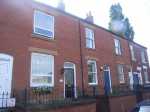 ames of streets called after the most well-known buildings of the place:
ames of streets called after the most well-known buildings of the place:
Great Tower Street - a street in the City, leading to the Tower.
Gray Inn Road - a street, where there was a building of one of "Lawyers' Inn" - a corporation of barristers in London (the building got the name of Gray's Inn after the name of its owner).
London Wall - a street running along the ex-city wall, which surrounded the medieval London.
B ishopsgate - a street in the city in the place where there was the road, built by the Romans, which ran from the city through the gate the northern side. After the ruined gates were restored in the Vth century by Erkenwald, bishop of London), they started to call the street Bishopsgate. In the XVIII century the gates were finally destroyed.
ishopsgate - a street in the city in the place where there was the road, built by the Romans, which ran from the city through the gate the northern side. After the ruined gates were restored in the Vth century by Erkenwald, bishop of London), they started to call the street Bishopsgate. In the XVIII century the gates were finally destroyed. 
Old Bailey - a street in the City, running in the medieval centuries along the tower rampart called Bailey which was made as an additional fortification behind the city wall.
-
Names of street called after old signs. In the medieval London where there were very few literate people instead of numeration of houses used bright sign places over the entrance to houses. Some signs were so well-known that they became names of streets or roads, passing nearby. In these names one can often find the words Bull, Unicorn, Angel:
A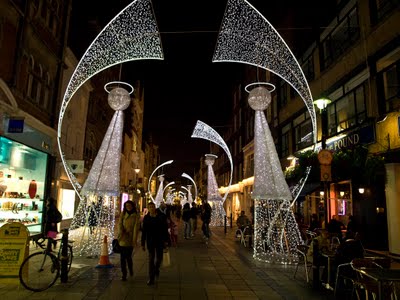 ngel Street, Angel Court - the names of the streets are connected with the sign showing an angel. In medieval times they believed that such picture defends the house and its inhabitants from evil eye.
ngel Street, Angel Court - the names of the streets are connected with the sign showing an angel. In medieval times they believed that such picture defends the house and its inhabitants from evil eye.
Bull Alley - the name of the lane is connected with the sign of a bull. Such signs often meant a tavern where there were popular in middle ages bull baiting of a bull with dogs.
Unicorn Passage is the name of the street coming from one of the sigs depicting a unicorn. In medieval centuries such signs were used by inn-owners as a sign of the fact that the people who stayed there would not be poisoned and also by apothecaries who prescribed to this mythological creature an ability to cure people from many diseases.
-
Names of streets called after geographical places. The most famous of them are the names of streets connected with rivers flowing (or which used to flow) through the territory of London:
The Strand - literally "bank". The name of Strand existed as early as in 1185 and it may have even more ancient origin. The road in those days in fact ran on the very bank of the Thames but little by little people occupied more and more of the ground from the river and after building of Victoria Embankment the Strand Street found itself quite far away from the Thames.

Fleet Street, Fleet Lane - a street, called after the river Fleet which was put into a pipe, while new houses were built in the district.
Water Street - literally "street, leading to water". Before the building of the embankment several streets having the same name ran to the Thames/ Nowadays only one street has this name.
Anglers Lane - literally "a lane of a fisherman". Next to this lane the river Fleet has its source.
Battle Bridge Road - a street called after the name of the old settlement Battle Bridge near one of the bridges across the Fleet River.
Turnsmill Street - street called after the nickname of the Fleet river (there were several watermills on it that is why it was called Turnmill Brook).
-
Names of streets called after names of convents, churches:

Ave Maria Lane, Amen Corner are lanes where there lived clerks who earned their living rewriting church texts and prayers.
Blackfriars Lane - a lane in the city called after a convent of Dominic.
 Whitefriars Street is a street called after the Carmelite monastery.
Whitefriars Street is a street called after the Carmelite monastery.
St.George's Street, St. Martin's Lane, St.Michael's Alley - a street and a lane called after the names of churches found there.
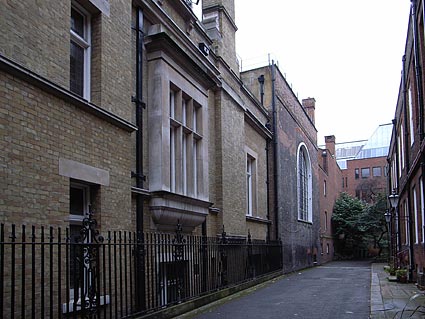
Paternoster Row - a street in the area of St.Paul's Cathedral where since the XIVth century they produced and sold rosary for prayers. It is one of the oldest streets of the City.
-
Names of streets called after the names of landlords and landowners, names of educational enterprices:
Bedford Square, Bedford Avenue, Bedford Place, Bedford Passage, Bedford Street are the streets made on the lands which belonged to the earls of Bedford.
Grossvenor Square, Grossvenor Crescent, Grossvenor Gardens, Grossvenor Hill, Grossvenor Gate, Grossvenor Place, Grossvenor Road, Grossvenor Street, their names atr connected with the family name of the Grossvenors, who owned numerous houses and land areas in London. 
Rugby Street is a street in London which appeared on the land which belonged tone of the oldest men's private schools Rugby (the school itself is in the town of Rugby).
Oxford Square, Cambridge Square were founded in London on the land which belonged to the Oxford and Cambridge Universities (in the XVth century these areas were presented to these universities to pay the students' grants).

Covent Garden is a street made on the land which belonged to the Westminster Abbey (Covent Garden is distorted "convent garden"). The monks who owned the land till the middle of the XVIIth century, grew fruit and vegetables on it and sold them. Since 1661 till 1974 there was the main London wholesale market where they sold fruit, vegetables and flowers on it. It has been moved to the area of Vauxhall.
Skinner Street is a street situated on the land which used to belong to the company of skinners (one of numerous guilds which appeared in London in the medieval ages).
-
N
 ames of streets called after monarchs, members of the royal family, famous military leaders and others:
ames of streets called after monarchs, members of the royal family, famous military leaders and others:
Victoria Street, Victoria Road,
Victoria Embankment,
Prince Albert Road. All these streets got their names after Queen Victoria (reigned since 1837 till 1901) and her husband Prince Albert.
Dombey Street was called this way after the characters of the novel written by Charles Dickens "Dombey and Son".
W ellington Place, Wellington Road, Wellington Street. These names are connected with the name of Earl Wellington who commanded the English troops during the battle of Waterloo (1815) and won the victory over the army of Napoleon.
ellington Place, Wellington Road, Wellington Street. These names are connected with the name of Earl Wellington who commanded the English troops during the battle of Waterloo (1815) and won the victory over the army of Napoleon.
-
S
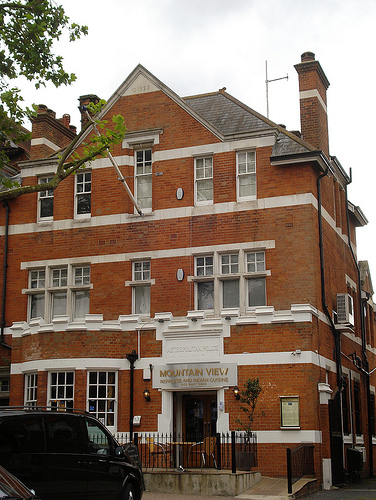 o-called advertising names of streets:
o-called advertising names of streets:
Paradise Row - literally "a street of Paradise"
Prospect Terrace - literally "the street of hope"
Meads Road - literally "a meadow street"
Mountview - literally "a view to a mountain".
Streets with such names are situated on the skirts of the city, in poor quarters of East-End. The appearance of these streets is far from the names they have.
The second element of street names
Special interest have words representing the second element of the names of the streets: Street, Road, Avenue, Terrace, Lane and others. In the modern usage the differences in their meaning are to some degree wiped off, though each of the terms in its historical meaning had its specific meaning which did not let identify it with others.
The term street has its source from the Roman via strata -"cobbled road". After the Romans left, the art of cobbling roads was forgotten but the word street remained and got a new meaning - "a road between houses".
The term road is connected with the verb to ride. In middle ages it referred to the roads where horsemen rode. It is interesting to know that in the central districts of London (the City, the Westminster) there are nearly no words road as the second element; at the outskirts such names are used much more often than names having as the second element the word street.
The term lane was used in medieval London for the streets which were not wide enough for loaded carts to pass by.
The term hill and rise are used in the names of the streets running down the slopes of some hill.
The streets situated in low places have as the second element of the name the word vale.
In the names of the streets one can often find such terms as yard and court, which historically meant approximately the same - a fenced off open space next to a hotel or inn. At the same time the word court associated with the royal court is used in the names of the streets more often than the word yard.
In 1661 after the building of Bloomsberry Square the term square appeared for the first time. Later as the second element of the names of streets they began to use the words
-
crescent - "semicircle"
-
circus - circle, square
-
place - square, street
-
avenue - a wide street, lined with trees
-
terrace - a line of houses along the street and so on.
The story of the term mews, which one can see in the names of the streets, is interesting. In medieval times when falcon hunting was very popular Royal Mews were situated in the place of nowadays Trafalgar Square. In the XVIII stables were built in their place and the word mews got the name of a stable. Later they started to call with this word not only stables but houses where cabmen lived. Thus the term got into the names of streets (such as Stratford Mews). As the second element of the names of streets you can also see the words used for advertising: garden, walk, grove, park, drive, ride.
From the history of Ufa streets
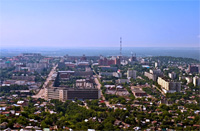
T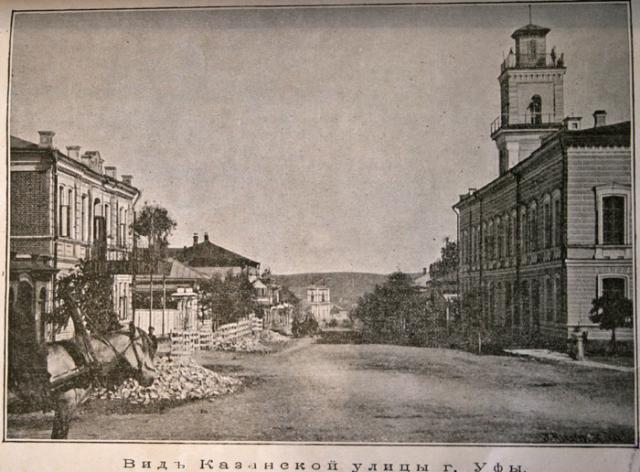 he first streets in Ufa were Posadskaya, Sibirskaya, Kazanskaya, Ilyinskaya, Frolovskaya, Usolskaya, Budanovskaya, Sergievskaya and Moskovskaya.
he first streets in Ufa were Posadskaya, Sibirskaya, Kazanskaya, Ilyinskaya, Frolovskaya, Usolskaya, Budanovskaya, Sergievskaya and Moskovskaya.
The oldest street of Ufa was Bolshaya Kazanskaya (still earlier Rechnaya Sloboda). According to scientists it is about 400 years. Some people say it was named after the Cathedral of Kazan Mother of God, according to another source, it got its name after the Tower of Ufa, which is considered to be the beginning of Ufa: there were six gates which defined the direction of streets. One of the gates was called Kazanskiye. It became the beginning of the street.
Mikhail Vasilyevich Nesterov who was born in Ufa in 1862 in his "Recollections" wrote that "at Epiphany the whole of Ufa went to Kazanskaya, the biggest street of the town which stretched from the centre to the Belaya river. This street is wide, comfortable for two of three line traffic."
The central street in Ufa at the beginning of the XIXth century was Bolshaya Kazanskaya (now Oktyabrskoy Revolutzii street), which connected the old part of the town with its new blocks. At the end of the XIXth century streets which linked the town with the railway station and Safronovskaya landing-stage became more important.
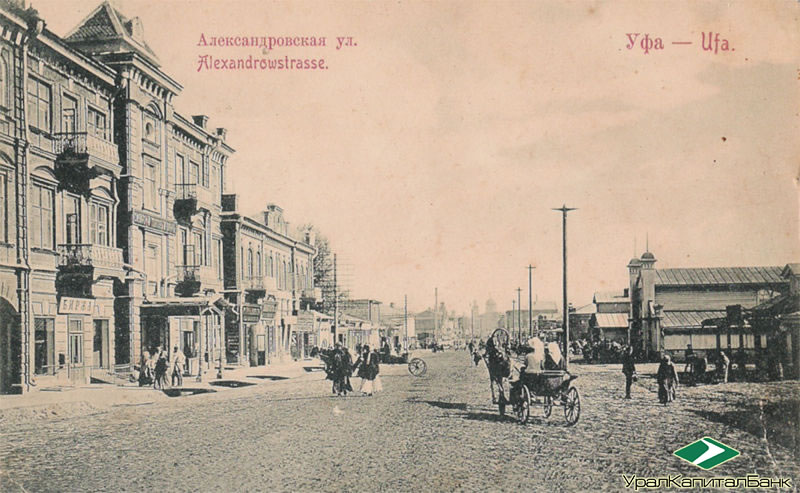
They were Lazaretnaya (later - Tzentralnaya, now - Lenin street), Aleksandrovskaya, Karetnaya (now Aksakova) and Bolshaya Vavilovskaya (Pushkin street).
T he whole net of the historical centre of Ufa was designed by an outstanding specialist in the градостроение of Russia architect William Geste who was invited from St.Petersburg for that. He came to Ufa in 1819 to make some adjustments to his main project which he had done in 1803.
he whole net of the historical centre of Ufa was designed by an outstanding specialist in the градостроение of Russia architect William Geste who was invited from St.Petersburg for that. He came to Ufa in 1819 to make some adjustments to his main project which he had done in 1803.
Lenin street is the live history of our city. It appeared before 1864. Its names were Bazilevskaya, Tzentralnaya, Zenzova), Since February of 1937 it has the name of Lenin Street.
The first post station in Ufa was situated in Vavilivskaya street, called after the name of the members of nobility the Vavilovs. At the same time the street had the name of Pochtovaya. In 1889 in honour of the 90th anniversary of Pushkin Vavilovskaya (Pochtovaya) was combined with Golubinaya Street and it got the name of the great Russian poet.
How many streets are there in Ufa? All in all there are 1237 streets. Their common length with the lanes is 1475,2 kilometres.
The first name of Sofya Perovskaya Street - Sredne-Usolskaya Street - was the continuation of Bolshaya Usolskaya Street (now Sochinskaya). Its name was changed after revolutionary Sofya Perovskaya who was on the 3rd of April 1881 in St.Petesburg. The street is in usolskaya (behind the Sutoloka river) part of Ufa and in the new district Belorechensky.
The first attempt to give readers information about the people whose names were given to the streets of Ufa was the book by Yuri Uzikov and P.Naimushin "What is your name, street?" (Ufa, 1977, 1980).
In 2007 the new book by Uzikov "Names of the streets of Ufa", where there is more information about the streets of Ufa and the people they were named after. In Ufa there are 253 streets named after famous people.
The organization of public services and amenities of the streets of Ufa was started in 1840s. To improve the roads there was founded a special tax from living houses. With the money they started to make road-ways. The first streets with road-ways were Sobornaya Street (now Teatralnaya), Bolshaya Kazanskaya, Aleksandrovskaya (the beginning of Karla Marksa street, Sobornaya Square (the territory of the Bashkir Drama Theatre) and others.
Nowadays there are more than 1400 streets in Ufa.
In our research work we made an attempt to create the classification of the streets of Ufa according to their origin and we got seven definitely distinctive groups:
-
Names of streets connected with geographical places, majority of which are called
-
after cities and all sorts of settlements:
Bakinskaya Street, Kislovodskaya Street, Yanaulskaya Street…
-
after rivers, seas, oceans, lakes:
Amurskaya Street, Zilimskaya Street, Ilmenskaya Street, Kaspyiskaya Street, Arkticheskaya Street, Baikalskaya Street…
-
after mountains:
Alpyisky Pereulok, Yangantau Street…
-
after ex-USSR rebublics:
Gatchinskaya Street, Gruzinskaya Street, Byelorusskaya Street…
-
Names of streets connected with names of national heroes, writers, artists, revolutionaries and so on:
Aleksandra Matrosova Street, Salavata Yulaeva Prospect, Aivazovskogo Street, Lenin Street and others.
-
Names connected with nature:
Yelovaya Street, Zhuravlinaya Street, Zvezdnaya Street, Snezhnaya Street…
-
Names connected with
-
places:
Pereulok Stolichnyi, Okrainnaya Street…
-
buildings:
Zavodskaya Street, Stadionnaya Street…
-
Names given to street after all sorts of professional activities of people:
Armeyskaya Street, Generalskaya Street, Geologov Street…
-
Names of Streets connected with transport:
Parovoznaya Street, Tramvaynaya Street…
-
Names of streets connected with the historical events:
Fifty Years of October Street, Bashkirskoy Kavdivizii Street…
-
Neutral names, some of which can be referred to advertizing:
Street of Nadezhdy (Hope), Otradnaya Street, Skazochnaya Street…
Conclusion
If we compare the names of streets of London and of Ufa we cannot but see that on the one hand there is definite similarity: both in London and in Ufa you can see names connected with labour activity and everyday life, names of places, plants, different cities, settlements, buildings.
At the same time unlike London in Ufa there are nearly no streets which have kept their primary names, very few street names are connected with churches. Very many street names are connected with politics and the revolution. It is explained with the historical development of out country.
We also tried to measure the share of the main six groups of streets of Ufa. This is what we got:
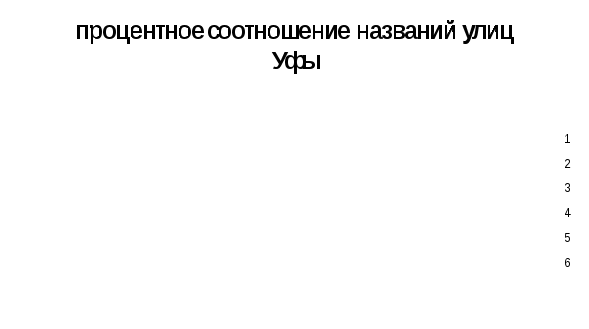
-
Geographical names
-
Names after famous and outstanding people
-
Places and buildings
-
Historical events
-
Nature
-
Professions
The List of literature:
-
О названиях улиц Лондона. А.Ф.Артемова, О.А.Леонович. ИЯШ № 3, 1983.
-
A Book of Britain. L., 1977.
-
Великобритания. Лингвострановедческий словарь. М., 1978.
-
Macmillan English Dictionary for Advanced Learners. London. 2006.
-
Baranovsky L.B., Kozikis D.D. Panorama of Great Britain. Minsk. 1990.
-
London. Tourist's Guide. London. 1979.
-
500 вопросов и ответов об Уфе. Уфа, «Панорама Башкортостана», 2009.
-
Юрий Узиков. Уфимских улиц имена. - Уфаю Уфимский полиграфкомбинат, 2007.
Content
Preface p.1
Types of street names p.1
The second element of street names p.9
From the history of Ufa streets p.11
Classification of streets names of Ufa p.13
Conclusion p.15
List of literature p.16
Content p.17

17


